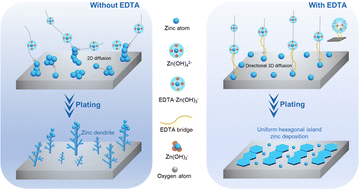An artificial bridge between the anode and the anolyte enabled by an organic ligand for sustainable zinc-based flow batteries†
Abstract
Zinc-based flow batteries are receiving huge attention due to their attractive features of high energy density and low cost. Nevertheless, their reliability is normally limited by dendritic zinc in the anode, which is influenced by the enormous difference in the transfer rate of zinc species in bulk solution and their electrochemical reaction rate at the anode. Here we engineer an artificial bridge between the anode and the anolyte enabled by organic ligands to realize fast transfer of zinc species from bulk solution to the interfacial region of the anode for zinc-based flow batteries. The ligands serve as the bridge in constructing a directional three-dimensional transport channel for zinc species first by coordination with zinc species and then adsorption on the surface of the anode, which enables a highly uniform and dense zinc morphology. Remarkably, an alkaline zinc–iron flow battery cell stacked with the organic ligand in the anolyte achieves stable cycling for ∼700 hours at 40 mA cm−2 with an average coulombic efficiency of 98.04% and an energy efficiency of 88.53%, respectively. This work presents a promising solution to address the issue of zinc dendrites and offers a path for developing highly reliable electrolytes for low-cost and sustainable zinc-based flow batteries.



 Please wait while we load your content...
Please wait while we load your content...